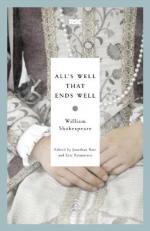|
This section contains 4,779 words (approx. 16 pages at 300 words per page) |

|
SOURCE: “All's Well That Ends Well as Noncomic Comedy,” in Acting Funny: Comic Theory and Practice in Shakespeare's Plays, edited by Frances Teague, Associated University Presses, 1994, pp. 40-51.
In the following essay, Free maintains that despite its conformity to comic formulae, comedy is thwarted in All's Wells That Ends Well through the play's representation of the power dynamics of marriage and metalanguage.
The title of All's Well That Ends Well suggests potential for mistaken identity, intrigue plot, thwarted romance—the stuff that makes comedy and the comic—and in its way the play fulfills those potentials. All does end well at least in the sense that girl does get boy despite all obstacles.1 In gross structure and plot, All's Well That Ends Well also conforms to comedy's basic outlines as they appear in other Shakespearean plays. Bertram's flight from authority figures—King, Countess, Helena—and their rules and...
|
This section contains 4,779 words (approx. 16 pages at 300 words per page) |

|


